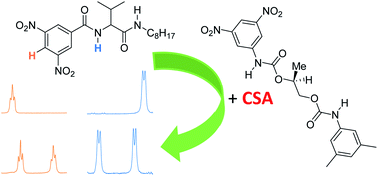Chiral mono- and dicarbamates derived from ethyl (S)-lactate: convenient chiral solvating agents for the direct and efficient enantiodiscrimination of amino acid derivatives by 1H NMR spectroscopy†
Abstract
New chiral solvating agents (CSAs) for NMR spectroscopy have been obtained from ethyl (S)-lactate, a very cheap commercially available product. By a sequence of simple chemical modifications of its functional groups, monocarbamoylated and dicarbamoylated derivatives were obtained, the potentialities of which as CSAs for NMR spectroscopy have been explored. Their ability to differentiate the resonances of enantiomeric mixtures of amino acids bearing a 3,5-dinitrobenzoyl moiety at the amino group and with the carboxyl function derivatized as methyl ester or amide has been probed. Almost every CSA was able to originate enantiodiscrimination in the 1H NMR spectra, with (2S)-1-(3,5-dimethylphenylcarbamoyloxy)-2-(3,5-dinitrophenylcarbamoyloxy)propane (4) standing out for efficiency and versatility.



 Please wait while we load your content...
Please wait while we load your content...